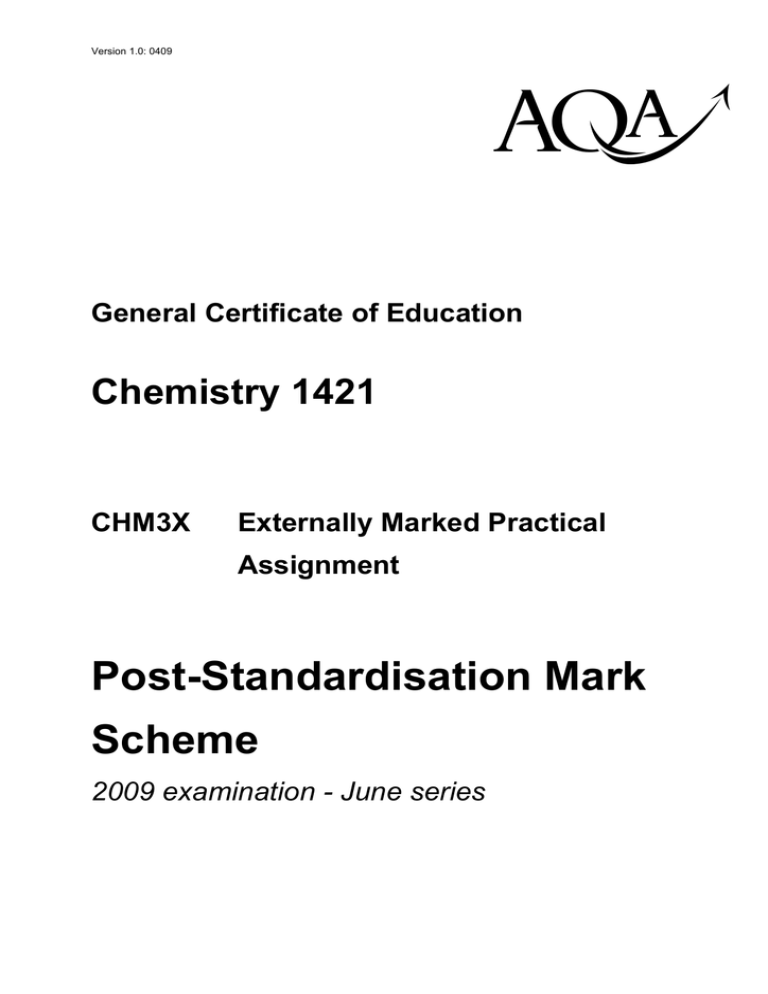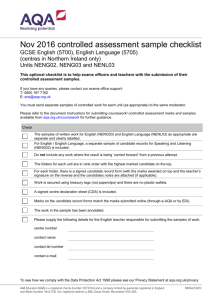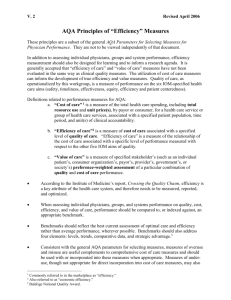
Version 1.0: 0409
hij
General Certificate of Education
Chemistry 1421
CHM3X
Externally Marked Practical
Assignment
Post-Standardisation Mark
Scheme
2009 examination - June series
Mark schemes are prepared by the Principal Examiner and considered, together with the
relevant questions, by a panel of subject teachers. This mark scheme includes any
amendments made at the standardisation meeting attended by all examiners and is the scheme
which was used by them in this examination. The standardisation meeting ensures that the
mark scheme covers the candidates’ responses to questions and that every examiner
understands and applies it in the same correct way. As preparation for the standardisation
meeting each examiner analyses a number of candidates’ scripts: alternative answers not
already covered by the mark scheme are discussed at the meeting and legislated for. If, after
this meeting, examiners encounter unusual answers which have not been discussed at the
meeting they are required to refer these to the Principal Examiner.
It must be stressed that a mark scheme is a working document, in many cases further
developed and expanded on the basis of candidates’ reactions to a particular paper.
Assumptions about future mark schemes on the basis of one year’s document should be
avoided; whilst the guiding principles of assessment remain constant, details will change,
depending on the content of a particular examination paper.
Further copies of this Mark Scheme are available to download from the AQA Website: www.aqa.org.uk
Copyright © 2009 AQA and its licensors. All rights reserved.
COPYRIGHT
AQA retains the copyright on all its publications. However, registered centres for AQA are permitted to copy material
from this booklet for their own internal use, with the following important exception: AQA cannot give permission to
centres to photocopy any material that is acknowledged to a third party even for internal use within the centre.
Set and published by the Assessment and Qualifications Alliance.
The Assessment and Qualifications Alliance (AQA) is a company limited by guarantee registered in England and Wales (company number 3644723) and a registered charity (registered charity number 1073334).
Registered address: AQA, Devas Street, Manchester M15 6EX
Dr Michael Cresswell Director General
Part
(a)
(b)
Question
1
1
Task 1
General
points
Sub Part
Ignore ‘milky’, cloudy’ or ‘opaque’.
3
If 'precipitate' missing in the answer, penalise each
omission.
If centre puts ‘orange/yellow’ allow ‘orange’ or ‘yellow’.
‘Clear’ is not the same as ‘white’ or ‘colourless’.
Look for the basic colour; ignore additional shades if the
answer is unambiguous.
If answers contradict e.g. "No visible change with white
precipitate" then scoring point is not awarded.
Keep these discrepancies in mind when marking the
scripts; allow either the published answer or the teacher
alternative.
Check the teacher observations against the published grid,
noting any significant discrepancies.
Results recorded clearly in a sensible table;
Marking Guidance
Comments
If you can read it, it is clear.
Full means completes all of the boxes.
Allow answer outside the box.
Allow without box lines but must be in
tabular form.
Mark
1 (R)
Chemistry - AQA GCE Mark Scheme 2009 June series
(b)
(b)
(b)
(b)
1
1
1
1
(iv)
(iii)
(ii)
(i)
4
White precipitate
1 (A)
1
Insoluble in excess;
Na2CO3 solutions
1 (A)
White precipitate;
NH3 solution
1 (A)
1
Insoluble in excess;
No visible change;
1 (A)
White precipitate;
H2SO4 solution
NaOH solution
See Additional Guidance to 1 (b)(i)
See Additional Guidance to 1(b)(i).
Accept no change, no reaction, stays
the same, colourless solution as
alternatives to ‘no visible change’
Accept no change, no reaction or
stays the same as alternatives to
‘insoluble in excess’
Accept sediment or solid deposit as
alternatives to ‘precipitate’.
Do not accept cloudy, suspension,
milky, opaque, misty or emulsion
Chemistry - AQA GCE Mark Scheme 2009 June series
Part
(a)
(b)
(c)
(d)
Question
1
1
1
1
Task 2
Sub Part
3
2
1
Average titre is within 1.5% of teacher value;
Average titre is within 2% of teacher value;
Average titre is within 2.5% of teacher value;
5
4
Average titre is within 1% of teacher value;
1(C)
Concordant if two results are within 0.10 cm3 of each other;
(A)
1 (P)
All titre volumes to 0.05 cm3 ;
The accuracy of the candidate’s average titre, measured
against a teacher value for the titration:
If you can read it, it is clear.
Full means initial volume, final volume and
titre volumes for at least two titrations.
Table does not have to have gridlines.
Allow clear answer outside of a table box.
Lose this mark if there is an arithmetic error
in calculating a titre.
Units are not needed in this results table, but
if given they must be correct.
Labels such as initial reading, final reading
etc are not needed in this very familiar table.
1 (R)
Results recorded clearly and in full in a sensible table;
4 max.
If a student has two concordant results then
both concordancy and accuracy marks can
be awarded.
If a student does not have two concordant
results but does have two results within
0.2 cm3, then the concordancy mark
cannot be awarded but the accuracy
marks can.
Results outside of 0.2 cm3 cannot receive
concordancy or accuracy marks.
Choose the combination of concordant
results that gives the highest accuracy
mark.
Award the mark for concordancy if the table
contains at least two concordant results,
even if candidate has not recognised these
as concordant results.
Allow zero entries as 0 or 0.0
Comments
Mark
Marking Guidance
Chemistry - AQA GCE Mark Scheme 2009 June series
1
1.25 x 10-2;
Answer to question 5 - answer to question 4;
Answer to question 6 divided by 2;
5
6
7
8
Must divide answer to q6 by 2 to score mark.
Ignore precision of answer.
Allow answer without working.
Must divide 0.52 by answer to q7 to score
mark.
Allow answer without working.
Any Mr given to 1 dp scores the second
mark.
1
1
0.520 divided by answer to question 7;
Answer given to 1 dp;
Must subtract answer to question 4 from
answer to question 5 to score mark.
Ignore precision of answer.
Allow answer without working.
Allow answer without working.
Must multiply answer to question 3 by 0.1 x
10-3 to score mark.
Ignore precision of answer.
Allow answer without working.
Ignore precision of answer.
If candidate has not indicated concordant
results to be used, this answer must equal
your average titre to score mark.
Penalise excessive rounding.
Allow answer without working.
Accept ‘no change’, ‘no reaction’, ‘stays the
same’, ‘colourless solution’ as alternatives to
‘no visible change’
Consequential on candidate’s result.
Comments
1
6
1
Answer from q3 multiplied by 0.1 x 10-3;
4
1
1
Correct average titre using the candidate’s indicated
concordant results ;
3
1
Expect white ppt/ BaSO4 insoluble;
1
Mark
1
NH3/ CO32-;
No visible change with H2SO4;
Marking Guidance
2
Sub Part
White ppt, (insoluble in excess), with NaOH/
Part
1
Question
EMPA Test
Chemistry - AQA GCE Mark Scheme 2009 June series
1.48 or 1.49 or 1.50 or 1.5 (g);
0.0124 (mol);
(1.49/ 0.0124) = 119.4 – 125.0;
11
12
13
Draws a best fit straight line
7
Must divide answer to question 11 by answer
to question 12 to score first mark.
Allow consequential answer from question
11.
Allow answer without working.
Ignore precision of answer.
Accept 0.012, 0.0125
Allow answer without working.
1
1
Accept these answers only
Ignore precision of answer.
Allow range 1.48 – 1.5
Award this mark if the line is close to your
line.
Award this mark if best fit line is consistent
with candidate’s plotted points.
Lose this mark if line is kinked or doubled.
1
1
1
Lose this mark if the plotted points do not
cover at least 9 squares by 7.
Lose this mark if the graph plot goes off the
squared paper.
The graph does not have to start at the origin.
1
Sensible continuous scales;
Plots points correctly ± one square;
If axes unlabelled use data to decide if mass
of mineral is on the x-axis.
1
Mass of mineral on x-axis;
10
If correct calculation gives 1.3, allow 1, 1.3 or
2.
Allow answer without working.
Ignore precision of answer.
1
[(answer to question 8) - 84.3] divided by 18;
9
Chemistry - AQA GCE Mark Scheme 2009 June series
21
20
19
8
No gas produced in stomach/ won’t cause wind;
1
Atom economy for Reaction 2 is (40.3/58.3) x 100 = 69.1% 1
Atom economy for Reaction 1 is (40.3/84.3) x 100 = 47.8% 1
1
MgCO3.3H2O;
Do not allow ‘gas produced’ on its own.
Maximum 1 mark if no working.
Ignore precision of answers.
54/138.3 + 39.05%
MgCO3.3H2O without working scores 1 mark.
Allow Mr of MgCO3.H2O = 138.3
1
39.05/18 = 2.170 and 60.95/84.3 = 0.723;
Do not allow ‘to make fair test’ or ‘improve
reliability’
Do not allow ‘errors’ on its own.
Do not allow ‘to make fair test’ or ‘improve
reliability’
Accept to ‘remove all carbon dioxide and
water’.
Do not allow ‘to make fair test’ or ‘improve
reliability’
Do not allow ‘takes too long’ or ‘wastes
chemicals’
Do not allow ‘not all of the water removed’.
(b)
18
1
1
Allow consequential answers from
candidate’s graph
Do not allow ‘so results are accurate’.
Allow anomaly clearly indicated on the
graph.
Allow consequential answer from question
13.
Allow correct calculation of x
1
Percentage errors too high/ errors in weighing too high;
(a)
18
Incomplete decomposition or words to that effect;
Ensure reaction/decomposition goes to completion;
1
Anomaly at 1.34 g;
17
1
Good/ straight line so results good/ reliable;
16
1
x must be a whole number;
15
1
Answer to question 14 close to 120.3;
14
Chemistry - AQA GCE Mark Scheme 2009 June series
(b)
22
(a)
(b)
24
24
23
(a)
22
Orange to green;
Eliminate/ reduce fire risk;
9
1
1
1
Filter to isolate strontium sulphate;
Need full colour change to score mark.
Allow ethanol flammable/ burns/ combusts.
Do not allow ‘drain’ or decant’
Allow correct acid eg nitric acid.
Do not allow volume / time.
Accept ‘steepness’ or ‘slope’
1
1
Do not allow ‘amount’ or concentration of
reactants.
1
Add (hydrochloric) acid to the mixture;
Determine gradient;
Temperature/ pressure;
Chemistry - AQA GCE Mark Scheme 2009 June series





